Please Take Note: This is a review of the final game, but it might change slightly based on the success of the Kickstarter campaign. The game is being reviewed on the components and the rules provided with the understanding that “what you see is not what you might get” when the game is published. If you like what you read and want to learn more, we encourage you to visit the game publisher’s web page or visit the Kickstarter campaign. Now that we have all that disclaimer junk out of the way, on with the review.
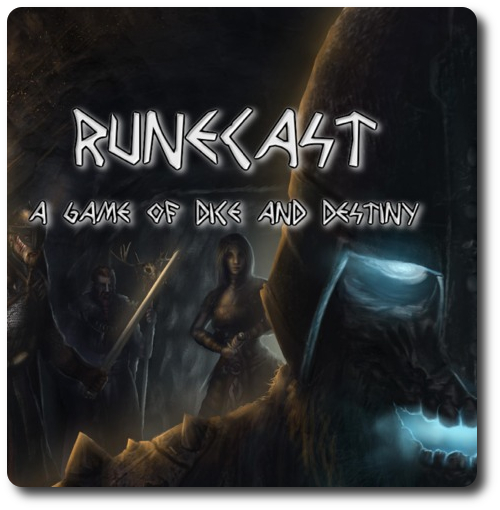
The Basics:
- For ages 7 and up (publisher suggests 10+)
- For 2 to 6 players
- Variable game length
Geek Skills:
- Active Listening & Communication
- Counting & Math
- Logical & Critical Decision Making
- Reading
- Pattern Matching
- Strategy & Tactics
- Risk vs. Reward
- Cooperative & Team Play
- Hand/Resource Management
Learning Curve:
- Child – Easy
- Adult – Easy
Theme & Narrative:
- Fight Loki to end the war of the Gods and Ragnarök
Endorsements:
- Gamer Geek approved!
- Parent Geek approved!
- Child Geek approved!
Overview
You lived a life of adventure and danger. As expected, you died young, but with honor. Songs are sung of your deeds and you feast for eternity in the halls of Valhalla. But there is trouble in Midgard and Loki’s mad mind is causing chaos and havoc. Odin himself has sent you back to Midgard to fight Loki’s minions and bring order to the world. You might have the blessings of the gods, but such trivial flatteries are nothing to a good blade.
Runecast, designed by Matt Voss and to be published by Charm City Games, will reportedly be comprised of 9 Battle boards (double-sided), 6 Character boards, 32 custom six-sided die, 32 Fate cards, 16 Loki’s Chosen cards, 6 Hero’s Fate cards, 7 Death tokens, 7 Health tokens, and 24 Breakpoint tokens. As this is a review of a prepublished game, I will not comment on the game component quality. I will state that the artwork by Carlos Jaramillo is outstanding. The characters on the Character boards are rough, tough, and very well detailed. Each Battle board is a landscape full of adventure, danger, and legends.
The Dawning of Adventure
To set up the game, either shuffle and deal out 1 Character board to each player or have each player select a Character board. Any Character boards not claimed by the players are returned to the game box.
Second, separate the cards into three different decks. You should have a Hero Fate deck, a Fate deck, and a Loki’s Chosen deck. Give each deck a shuffle and keep face-down.
Third, deal to each player 1 Hero Fate card. This card should be flipped face-up and placed next to the player’s Character board. Give each player 1 Health token. This token is placed on the highest number on the Hero Fate card. This is the character’s health track. Any Hero Fate cards not dealt are returned to the game box.
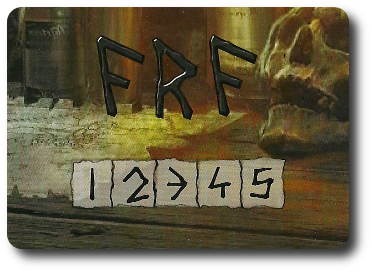
Fourth, deal to each player a set number of Fate cards. This is referred to as the player’s Fate hand. The number of Fate cards dealt is dependent on the number of players. Players SHOULD NOT look at their cards. They should remain face-down and in a single deck next to the player’s Character board. Any Fate cards not dealt are set aside. Leave room next to the Fate deck for a discard pile.
Fifth, either shuffle, use a sequenced scenario, or specifically select the Battle boards you want to use for this game. The total number of Battle boards to be played with is dependent on the number of players. Once selected, the Battle boards are placed in a stack in the middle of the playing area. Any House Rule can also be used when determining which Battle board will or will not selected. Each Battle board is double-sided, with each side representing a different challenge. Obviously, the challenge that takes longer to conquer is considered more difficult than those that are not. This allows players to tailor their game from “Easy” to “OH, MY GOD! WHAT HAVE WE GOTTEN OURSELVES INTO?!”
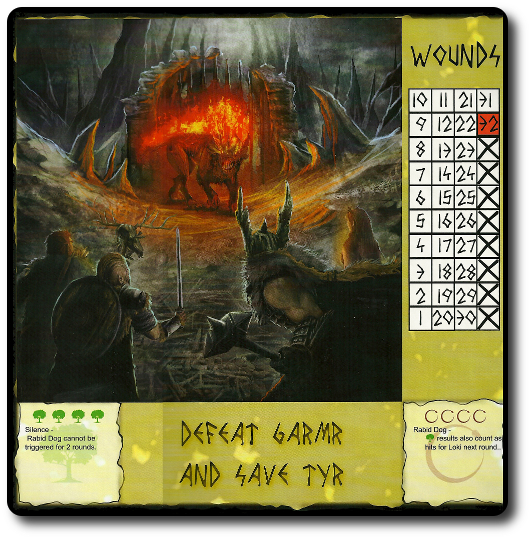
Sixth, place the Loki’s Chosen deck above the Battle boards, face-down.
Seventh, give each player a set number of dice. The number of dice given to each player is dependent on the number of players. Any dice not used are set side.
Eighth, give each player 1 Death token which is placed by their Character board and place 1 additional Death token next to the Battle boards. The Death token by the Battle boards is referred to as the “Community Death token”.
Ninth, place 1 Health tracker next to the Battle board. This will be used to keep track of the wounds the players inflict on the Battle board boss. Place the Breakpoint tokens to one side and within easy reach of all the players.
That’s it for game set up. Time to prove your worth to Odin once again.
Death Wish
Runecast is played in rounds and turns with no set number of rounds in the game. A round has 2 parts. The first part is reserved for the players, where they will take turns attempting to beat the Battle board. The second part is reserved for Loki who attacks the players.
Players’ Turn
Players will take turns going in whatever order they like, but no player can take more than 1 turn per round. Players should decide the turn order to maximize the damage and increase their odds of survival. On a player’s turn they will complete the following actions. The order in which they take them is up to the player. If the player had dice “locked” on their Character board from a previous turn, they are now “unlocked” and can be used.
Action 1 (Optional): Draw Fate Card
The Fate cards dealt to the players at the beginning of the game remain face-down until the player wants to reveal one. The Fate cards contain weapons and armor that will benefit the player in their private war against Loki and his minions. But fate is fickle and so are the Fate cards. The player might also have curses, traps, and ambushes that they will uncover. It’s also completely possible that one player is dealt a lot of negative cards, which begs the question: is the player just unlucky or is there some sort of sinister power at work?
“Weapon” Fate cards represent powerful and mystical forged weaponry that will help the players take down foes. Such weapons are legendary, but not eternal. When a player uses the “Weapon” Fate card (and use is always optional), they place 1 Breakpoint token on it. When the “Weapon” Fate card has a number of Breakpoint tokens on it that is equal to the Breakpoint number, the Fate card is discarded.
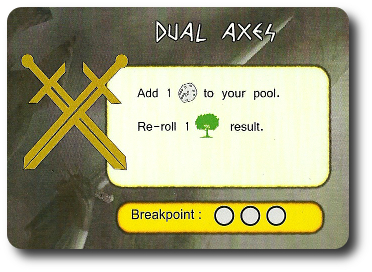
“Armor” Fate cards absorb damage instead of dealing it. Each piece of armor can absorb so many points of damage. When it absorbs a number equal to or higher than what it’s capable of, it becomes “Exhausted” and is tipped to show it can no longer protect the hero. When an “Armor” Fate card become exhausted, a Breakpoint token is placed on it. The “Armor” Fate card will become available to the player again on their next turn, but until then, the hero is without protective armor.
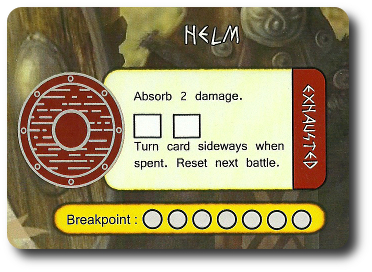
Some Fate cards are blessings and boons that are from the Norse Gods who want the heroes to win. Some of these can give players more dice to role or alter the results of the dice. Once they are resolved, they are discarded.
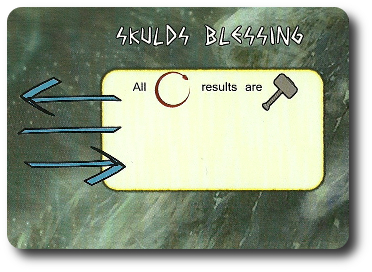
Fate cards that are harmful to the player and the party, are resolved once they are revealed. Once they are resolved, they are discarded.
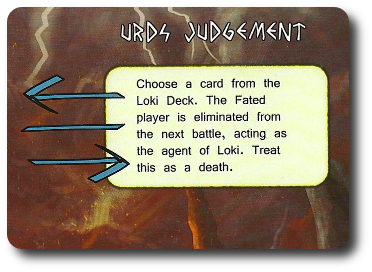
When drawing a Fate card, there are two important rules to remember. The first is that a player may have 1 “Weapon” and 1 “Armor” Fate card, but not 2 or more of both. A player’s character cannot go into battle with 2 “Weapon” Fate cards, for example. The second rule is that Fate cards of the same type replaced each other. If you had a “Weapon” Fate card in play and decided to draw another, your current “Weapon” Fate card would be replaced if the new Fate card was also a weapon. If it was a piece of armor, it can be played next to the weapon.
Long story short, the Fate cards are there for the players to use if they want to. They are never forced to. It’s a gamble if they use it, but sometimes desperate times call for desperate measures.
Action 2: Use Hero Ability (Optional)
Each hero has a special ability listed on the Character board. These can be used during the player’s turn or anytime during the game and as many times as they like. Each Character board has a unique ability, which gives the players a special challenge of determining when they should use them. Since this is a cooperative game, players are encouraged to recommend when an ability should or should not be used. If a player uses the hero ability now, they simply resolve it. If they want to use the ability later in the game, they must state they are using the ability before dice are rolled.
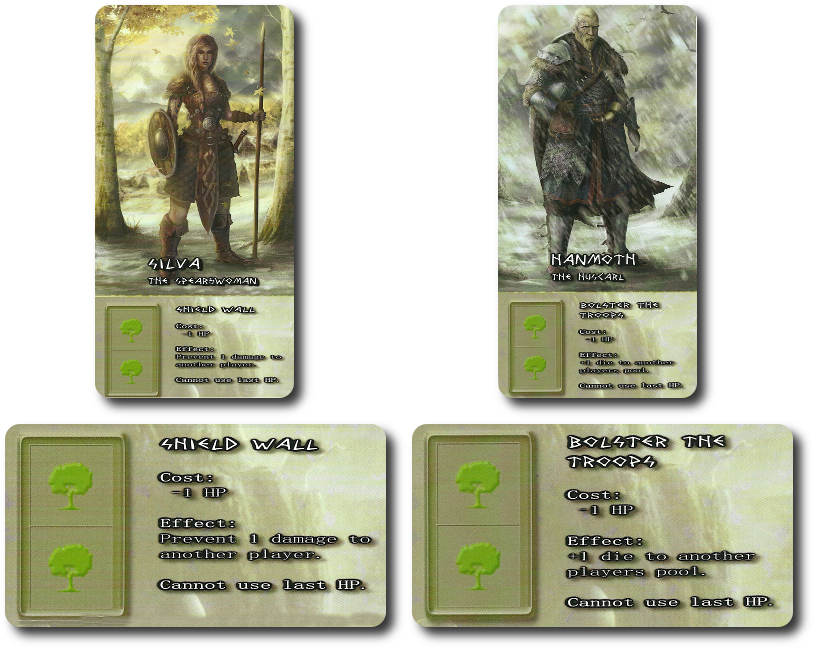
But such power comes at a price. Each time the player uses a hero’s ability, it costs -1 life. Players must be able to pay the price of their power in blood before it’s triggered. Players are also not allowed to sacrifice their hero by using their last life to trigger their ability.
Action 3: Roll Dice (Mandatory)
The player picks up their dice and rolls them. The player then assigns the values rolled. By default, the values mean the following:
- Mjölnir (Thor’s Hammer): This die value normally indicates damage.
- Yggdrasil (The World Tree): This die value normally indicates health.
- Jörmungandr (The World Serpent): This die value normally is reserved for Loki.
There are a number of ways you can go about completing this action. Here is the way we did it which worked well for all of our player groups.
- Separate all the dice values out into the three pools: Hammer, Tree, and Serpent.
- Look at the current Fate cards in play. If any of the cards change the values of the dice, you may chose to use them now.
- Take the Tree dice and place 1 die on the Character board for each life point you want healed. You cannot heal more than the maximum number listed on the Hero Fate card’s life track. Be cautious, however, as each die used to heal the hero will be “locked” until the end of the player’s NEXT turn.
- Set any Serpent dice rolled to the top of the Battle board. These now belong to Loki but will be returned to the player after the round is over.
- Reduce the Battle board’s life by -1 for every Hammer value rolled.
The player’s turn is now over. All dice rolled with the Hammer value and any Tree value dice not used for healing are returned to the player.
The next player to go now takes their turn using the actions noted above. When every player has taken their turn, Loki takes his revenge.
Loki’s Turn
See all those dice on the Battle board? Yeah, those belong to Loki and he is itching to use them. I suppose now is a good time to explain the Death tokens since Loki is about to unload a mythic can of kick butt on the players.
Each player is given 1 Death token. When a player’s hero perishes (which is likely against the more difficult bosses), the player can turn in the token to be revived during their next turn. All the players have access to the Community Death token, which works the same way as the player’s Death token, but it’s available to anyone. The players must collectively decide if that is OK, however, and there might be some strategic reasons why one player shouldn’t be given a second chance to return to the battle.
When a hero does return from the grave, they lose any “Weapon” and “Armor” Fate cards they might have in play. These are discarded and the player then draws Fate cards until they have the same number they started with at the start of the game. The new Fate cards are placed on the bottom of the player’s Fate hand.
The first player to go during the start of the round is referred to as “Loki’s Thrall”. This is nothing more than a title, really. Loki’s Thrall is just a fancy way of saying, “the player who is going to roll the dice” since the game is going to make most of the decisions on what happens to the players. If a player’s hero can no longer return to Midgard, they are Loki’s Thrall by default.
Loki’s Thrall picks up all the dice on the Battle board and rolls them. Here’s what happens next…
The Wrath of Loki
If 1 or more Hammers were rolled, Loki’s Thrall will draw the top Loki’s Chosen card and reveal it.The card will either show 3 sets of 3 runes each or a single set of 3 runes.
If the card shows 3 sets of 3 runes, the top-most set of runes might match the set of runes on a player’s Hero Fate card. If it does, that player’s hero takes 1 point of damage per Hammer. The player can use their “Armor” Fate card to block it and the other players can use their hero’s ability to reduce the damage. If there is no match for the first set, the second set down is used, and finally the third set if there is still no match. If none of the player’s Hero Fate cards match the runes, then no one gets hit and the card is discarded. If a player was hit, the card is also discarded.
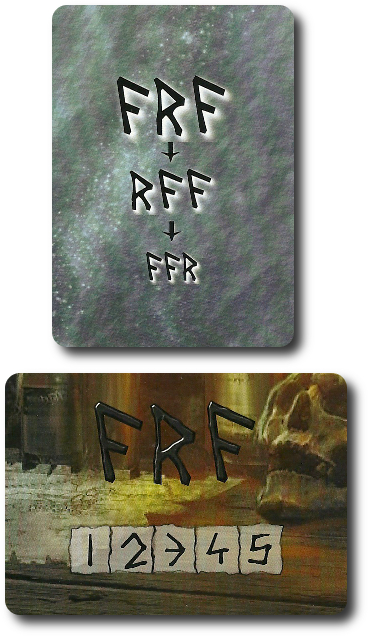
If the card drawn has three “FFF” runes, it means that all of that Hammer’s rolled are ignored. The gods have intervened and Loki will not be able to directly attack.
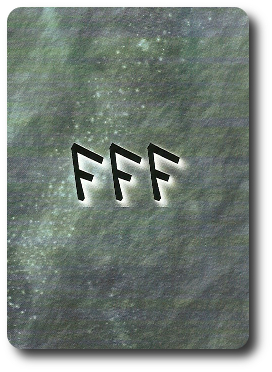
If the card drawn has three “RRR” runes, it means that Loki was able to outsmart the heroes and all the players take damage.

If Loki’s Thrall rolls all Hammers, a Loki’s Chosen card is not drawn. Instead all players take damage equal to half of the Hammers rolled.
In this way, fate once again plays a part in the life and death of the heroes, as well as the will of the gods.
Loki’s Magic
On each Battle board is a series of Serpent symbols. The number of symbols indicate how many Serpents must be rolled during this part of the round to trigger the Battle board’s special attack. Which, as you might have guessed, are pretty nasty. They are also associated with the type of Battle board the players are attacking. For example, if the players are fighting against a Battle board with the undead, the special attack deals directly with that type of monster. If the special attack has been triggered, it’s immediately resolved per the instruction provided on the Battle board.
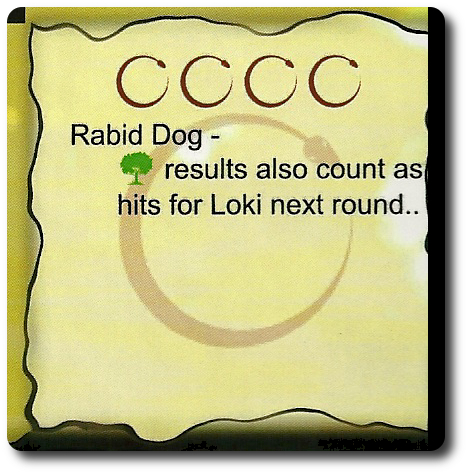
Each Battle board special attack can only be triggered once per round. For example, a special attack that requires 4 Serpents could not be triggered twice in the round if 8 Serpents were rolled. Some special attacks change dice rolls, influence the next round of play, heal Loki, and remove dice from player’s dice pools.
The Return to Balance
Fate, while fickle, does what it can to maintain a certain equilibrium throughout creation. The Battle board provides a special boon. Like the special attack, the special boon has a requirement that must be met before it’s triggered. In the special boon’s case, it’s Tree symbols. If the roll resulted in a number in Trees that meets the requirements of the special boon, it’s immediately triggered and resolved.
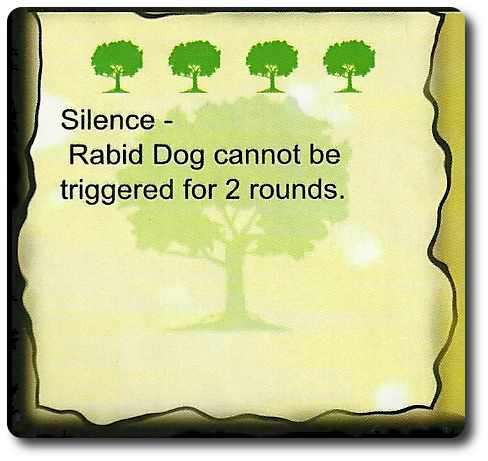
Special boons can only be triggered once. They can also influence future rounds, players, and the balance of the game.
Ending the Round
When all the dice have been resolved for Loki, each player will collect dice from the Battle board. The total number of dice a player has available to them throughout the game will change. Dice that were gained through Fate cards become part of the player’s dice pool. Dice that are reserved for healing are also part of the player’s dice pool, but are “locked” for a round of play. Finally, dice can be removed from the player’s dice pool through Battle board special attacks and Fate cards. Long story short, players will need to keep track of how many dice they have during the game and collect that many from the Battle board to refill their dice pool.
Note: We used a twenty-sided die to help players keep track of how many total dice they had. This worked great. We also created a House Rule that worked very well.
Defeating a Battle Board
When the player’s inflict enough damage so the wounds on the Battle board meet or exceed the red number on the wound tracker, the players have defeated it. The Battle board is removed from the game and the next Battle board in the stack is used. The Life token is placed next to it and any dice that might have been on the defeated Battle board return to the players.
A new round now beings. If the previous Battle board was defeated before all the players had a chance to act in the round, the next player to go would be any of the players who did not have a turn in the previous round. Or not. Doesn’t matter since all the players are working together. Decide as a team and move forward.
Returning to Valhalla
The basic victory condition calls for the players to go through and defeat each of the Battle boards they selected. Once the last Battle board is conquered, the heroes return to Valhalla, feast, drink, and wait to be called again by the gods.
Game Variants
A number of game variants are provided that are optional to use.
Random Battles
Instead of building a stack of Battle boards, randomly deal 1 Battle board and defeat it. Repeat as many times as you like.
Minimum Loki Pool
It is very possible that Loki will sometimes have a tremendous number of dice. If Loki’s Thrall rolls Hammers, a payer’s hero could die very quickly. This rules variant caps the total number of dice that can be set on the Battle board.
Unlimited Returns
The gods can only return the heroes to Midgard twice. This rules removes that limitation. Players can now return their hero as often as necessary.
House Rules
Runecast was purposely designed to allow for easy implementation of any House Rules. In the words of the game’s designer, “Make up any rules you want! If they make Runecast more fun for you and your friends, you’re playing the game the way it was meant to be played.” In the spirit of making the game the way we want to play it, here are a number of House Rules we used that worked very well.
A Well Earned Reward
When a Battle board is defeated, the special boon on the Battle board is triggered before a new Battle board is revealed. The boon might or might not be of any importance to the players.
Even Heroes Sleep
When a Battle board is defeated, all heroes are fully healed before the next Battle board is used. Thematically, the heroes took a little time off to rest, heal, and gear up for the next battle.
Sharing the Burden
Instead of making certain every player has an exact number of dice equal to their total dice pool, players can divide up the dice they way they want. This allows players to make sure that all heroes have the same number (or close to it) of dice to take down Loki or they can give more dice to one player who just so happens to have a really awesome weapon.
The Power of Ygg
When a player rolls their dice, they can “lock” 1 Tree value to re-roll all their dice or “lock” 2 dice with the Tree value to reroll only certain dice. This can be done as many times as the player likes. The “locked” dice are returned to the player after the end their turn in the next round.
To learn more about Runecast, visit the game publisher’s web page or visit the Kickstarter campaign.
Final Word
The Child Geeks who had played King of Tokyo before took one look at Runecast and immediately knew how to play it. They really liked the differences in the game from the very start and commented often how awesome their heroes were. One Child Geek said, “I feel like I’m on an epic adventure with my friends. Bring on Loki!” Another Child Geek said, “I like this game better than the other one. You get to work together and defeat really big monsters instead of being a monster.” The only part of the game the Child Geeks disliked were the harder Battle boards. Which, as you probably have guessed by now, is a very simple fix. You just remove them. We were able to tailor an adventure for our Child Geeks that challenged them, made them work together, discuss tactics and strategy at the table, and cheer as a team when a monster went down. Runecast also created some very tense moments for the Child Geeks. Each die roll was watched very closely and more than one Child Geek started mumbling silent wishes to their dice to “roll right”. When all the dice were put away, the Battle boards stacked, and Loki banish, the Child Geeks all agreed with much enthusiasm to approve Runecast.

CRUD! We awoke the Draugar! It’s up to me to take them out before they attack us. My little geeks are on pins and needles!
The more geeky Parent Geeks were first drawn to the illustrations on the Battle boards and the Character boards. They really are fantastic to look at. When we built our first adventure, we purposely added in a few ridiculously difficult Battle boards and kept the rest easy to moderate. The first Battle board went very smoothly, with the Parent Geeks discussing when they should use their Hero abilities and offering friendly advice. The second Battle board was an absolute killer and forced 2 players to use their Death tokens. The mood and intensity with the Parent Geeks shifted and they now talked like they were an adventuring party instead of just a bunch of grownups sipping brews and rolling dice. The third Battle board was approached with caution and conquered. During the game, one Parent Geek said, “I think a lot depends on luck, but I like how you never know how things are going to go. It’s not all bad, but when it is, damn.” Another Parent Geek said, “I like this game. It’s casual and quick. It can make you angry in one round and jumping for joy in the next. That’s a game worth playing.” All the Parent Geeks voted to approve it for themselves and for their families.
The Gamer Geeks were skeptical at first. When I explained the game to them, they immediately said it sounded like a cooperative version of King of Tokyo. After a few games, the Gamer Geeks had much to say. One Gamer Geek said, “This game is full of luck, but you can offset that with the Fate cards and hero abilities. Of course, you are literally tempting fate when you use them, but that’s part of the fun.” Another Gamer Geek said, “The only part of this game I don’t care for is not having more control over my dice. It would be nice to be able to roll them a few more times before I hand them over to Loki.” This was a common statement and a House Rule was created as a result. During one game, a Gamer Geek exclaimed, “I swear my dice are cursed every other round. I rolled all Hammers the last time and now I rolled all Serpents!” And when all the Battle boards were either defeated or the heroes were slain, the Gamer Geeks reflected on their earlier skepticism. A Gamer Geek broke the silence with this thought, “This is a light game, full of luck and fun. It’s total beer and pretzels with a healthy dose of fighting Norse monsters of epic proportions.” They found that Runecast was a light game of the beer-and-pretzels variety that offered quick game play, a fun challenge, and casual engagement. They all voted to approve Runecast.
Runecast is nothing more than pure candy. Rolling dice and defeating giant monsters with friends is always a good time. The game’s level of difficulty can be easily adjusted, ranging from a peaceful stroll through Midgard to a blood-soaked hellride. And that is one of the biggest wins for me when I was playing this game. I could easily adjust it to the audience, making it fun for everyone I played with.
The Gamer Geeks wanted a game that was gritty, difficult, and really challenge them. Runecast delivered.
The Parent Geeks wanted a casual game full of near misses and close calls. Runecast delivered.
The Child Geeks wanted a game where their heroes were mighty and could take down giants and gods. Once again, Runecast delivered.
In all cases, the same game was easily modified without fuss or muss to provide the right gaming experience. No need to get new components out, learn a bunch of new rules, or alter the core of the game. Any and all changes were light and without any noticeable damage to the game’s balance.
Speaking of balance, yes, Runecast is a luck fest. You have no control over the dice values, but you do have a say on how they are used. The more dice the players have, the more powerful Loki could be. This keeps the players and Loki in balance, despite luck playing a big role. The same randomness that the players must contend with is the same that impacts Loki. In all cases, the game does a good job of attempting to keep everything balanced enough to give the player’s room to think, but never enough room to feel safe. This game wants to beat the players over the head, but it’s the players who decide how quickly that will happen.
Which brings me to the Battle board. Man, I love these things. Each is an epic saga in its own right. You can string them together to create an incredible journey that takes the heroes to hell and back, concluding with the players fighting in Ragnarök. Yes, it’s that epic. It might not feel epic, however, since each Battle board is essentially the same when it comes to defeating it. But what is different and unique to each Battle board is how tough it is, the special attacks, and the special boons. This is enough to make each Battle board feel like a new challenge.
I’m very happy with Runecast. I think the ultimate testament to how much I enjoyed this game with family and friends is that I’m personally backing it. I already have a working copy and I can play it today as often as I like, but Runecast is a game I want to see made. It’s a game that will challenge a lot of younger gamers and casual players in a dark and gritty setting that demands team work and comradery as the players fight against incredible odds. It’s also a game that allow players to easily customize it, change the way the game is played, and make it their own. This is the kind of game I want to play and I know I’m not alone.
This is a paid for review of the game’s final prototype. Although our time and focus was financially compensated, our words are our own. We’d need at least 10 million dollars before we started saying what other people wanted. Such is the statuesque and legendary integrity of Father Geek which cannot be bought except by those who own their own private islands and small countries.



